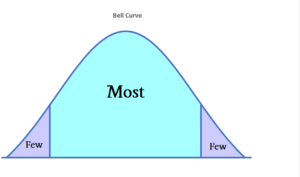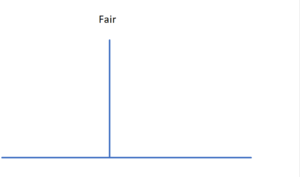In my personal, professional, and diabetes life I’ve noticed that things tend to exist in a bell curve. Or as it is known in statistics, a normal probability distribution. If we were to count the frequency different human behaviors, preferences, opinions, favorites, or choices, then group and sort them, the result will almost always be a bell curve distribution. There will be a lot of things most people prefer, do, choose or think that lump up in the middle. And, thank goodness, there will be some who live boldly on either side of the norm pushing the limits, challenging the status quo, or perhaps born with a gift or struggle. Some fall to the left of the center, some to the right. There are likely countless examples where this isn’t the norm, but for the sake of this blog, I’m going with my observations in life thus far. In a group of people, there will be a bunch that mostly agree, behave or think a certain way, and there will be some who are outliers.

Life is not fair
The bell curve also can be useful when talking about what is “fair”. In my humble opinion, life really isn’t fair in any shape or form. Bad stuff happens to people all the time. And good stuff happens to people we may believe don’t deserve it. The only way life is fair is if everyone gets the same and then the bell curve becomes a harsh 90-degree angle where everyone, every choice, every option is the same. Very vanilla, stark and boring if you ask me. By our very nature, we humans like choices, control and individuality. It is what makes the experiences of life interesting. Personally, I am a fan of the bell curve! What does this have to do with diabetes? Hang with me, I’ll get there!

Professionally speaking
In my clinical and my corporate world, my bell curve theory held true. In clinical practice, there are commonalities and general findings that apply to most people. You start there when assessing a person. Look for the most common possibilities (middle of the bell curve), then tweak and inquire for the unique person and situation (somewhere in the bell curve) until you (hopefully) understand their need. The middle of the bell curve provides insight into a general tendency or pattern, but to find the exact issue, you must dig a bit and venture into the midst of the bell curve. So many possibilities out there, but you start from a firm place of truth
Conversely, starting with the endless possibilities will lead you nowhere when you are trying to help someone. There are too many options and no clear path and you risk wandering all over the place and never finding a solution. The middle of the road is valuable for getting started.
Chaos
In my healthcare, IT experience, usability (or how easy it was to use the program) was a key focus of our designs. It had to be intuitive, easy and fast for the emergency department professionals who used it. When determining which features and workflows we added to the program, one of the considerations was how often did the need arises? If it was common, then the solution had to be super easy and obvious. If it happened once a year it might be a few screens in or handled with a text box just to type whatever they wanted. When you try to handle every situation and accommodate every possibility the easy stuff becomes very hard and the entire process gets bogged down.
Again, no global solution by trying to satisfy all the outliers. Addressing the middle of the bell curve is great for speed, but very unique needs, require individualized attention.
Politics
So I couldn’t talk about a bell curve and not mention the obvious right and left of politics. It is a perfect example of a bell curve of opinions. Some people leaning far to one side or the other. But if the bell curve theory holds up, most of us probably fall somewhere in the middle and we might agree on more than we disagree on. But the political process strives to force us to one side and agree with the outliers. And just like in my work experience, when we try to control all the variables in the outliers, the larger process gets bogged down and we lack solutions. Some things are meant to be unique, some general. None of it is fair or not fair. Is just is.
Insurance
The bell curve also shows up in insurance plans. I believe some of the reasons insurance is so complicated is that it tries to manage every possible scenario. There are actually billing codes for being struck by a spaceship or a duck, water skis on fire and personal problems with in-laws!! As systems try to manage the strange and unusual (the outliers), the easy and common (diabetes) become super complex! And then you don’t get the amount of insulin you need because of some crazy insurance rule.
Diabetes
I told you I would get to diabetes! Your diabetes life happens in a bell curve as well. If you have diabetes you have a place in this curve somewhere. It may be far to the one side with the uber technical and automated or the opposite extreme with those unable to figure it all out. Most likely you live somewhere in the middle of the pack, doing your best to live your life and manage your sugars.
Following my clinical experience, diabetes treatment tends to linger in the middle. Your doctor and diabetes team will get you started and should help and guide you to a place you towards your place. Unfortunately, no one can know your place except you. Excepting those who love you, there isn’t someone who will figure it out for you. And even your loved ones are more effective, when you share your needs, wants and preferences with them. A well-lived diabetes life means a LOT of self-advocating, explaining, questioning and perhaps demanding. Only you know the path to your place. It is yours to own. Your place is valuable. You are worthy of it.
Experience Life
It isn’t fair that you must carry this load, but it is the only way. Each of us are outliers when it comes to how to manage every moment of every day. We figure it out as we go. Hopefully learning some, and yes, struggling some, but always remembering we are still here to experience another day…. somewhere in the bell curve.
Peace,

Struggling to find your place in the bell curve? I can help! Sign up for a free introductory call!


0 Comments